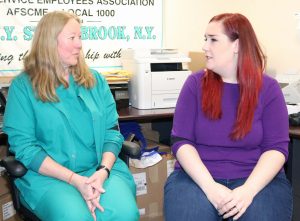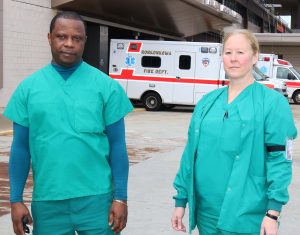‘If someone slams a door behind me, I want to run’

CSEA members discuss the most recent violent occurrence on the Stony Brook University Psych Ward at the SUNY Stony Brook Local office. From left, Teresa Morahan and Kristin Lehnert.
STONY BROOK — Kristin Lehnert is only 29 years old, but she has difficulty standing for long periods of time due to a bulging disk in her lower back.
Lehnert, a certified nursing assistant at Stony Brook University Hospital, was injured after being attacked by a patient who was “med seeking.”
She is just one of dozens of CSEA members working at Stony Brook University Hospital’s Comprehensive Psychiatric Emergency Program (CPEP) and longer-term mental health units who have had to endure ongoing workplace violence that they say has been increasing in frequency — and intensity.
Our union is fighting to keep Lehnert and her co-workers as safe as possible on the job. SUNY Stony Brook Local officers and members have been standing together to ensure that hospital management minimize potential violence risks.
“CSEA members at Stony Brook University Hospital who work on the psychiatric units are working under extreme conditions,” said SUNY Stony Brook Local President Carlos Speight. “However, they are definitely sticking with our union. As a strong union, we are doing everything we can to make our members’ work environment safe.”
Facing violence
Many workers have harrowing stories. Teresa Morahan, a mental health therapy aide, suffered a concussion and received stitches after a patient burst through a door and punched her in the back of the head, knocking her into a wall.
Before attacking Morahan, the patient had lunged at a doctor after he told the patient he would be admitted to the hospital, resulting in hospital staff contacting health and security staff to calm the man.
After an hour of counseling, the patient agreed to be sedated and the additional staff left the unit, leaving unit direct care staff to tend to the man and other patients.
“At that point, the patient was walking up and down the hallways, stating that he wasn’t going to go to the hospital and that he was going to hurt somebody instead,” said Morahan.
“What’s really pertinent about this situation is that hospital staff knew this was a hot situation,” said Dorothy Neilsen, a mental health therapy aide. “Twenty people came to talk to the patient and then they all left, and we [the aides]were left with him.”

Eunice Brown, a nursing assistant 2, and Teresa Morahan, a mental health therapy aide, shown here outside Stony Brook University Hospital, are among the hospital staff who are facing violence on the job.
Eunice Brown, a nursing assistant 2, was forced out of work for eight months after being put in a choke hold by a patient. During the attack, he lost consciousness. Brown was only saved when another patient pulled the assailant away from him.
These ongoing attacks have affected many of our members who work on these units.
“I have developed PTSD [Post Traumatic Stress Disorder] due to my incident,” said Morahan. “If someone slams a door behind me, I want to run. It’s very scary.”
While our members are committed to providing quality care to the patients, the incidents have also affected our members’ ability to give this care.
“I was walking with a patient when I was told by a nurse that I was going into an area with no cameras,” said Lehnert. “She told me not to go back there because if I scream, nobody will be able to get to me. I was in a situation where my patient wants to watch TV and I can’t take him there because it’s not safe for me. That kind of thing can agitate the patients and make them violent.”
Understaffing increases risks
Our members also note that hospital management has also occasionally moved CPEP unit workers to staff other hospital units, often leaving the psychiatric emergency unit understaffed, which is a potential safety risk.
“We can’t control whether new patients come into the unit because there is no stop gap,” said Morahan.
“We might have the police pull up with new patients, have several people in the waiting room and then the ER is bringing in patients, all at the same time.”
“We need to have more staff,” Lehnert said. “You physically and mentally cannot split yourself enough to make sure that you are paying attention to [patients’] needs.”
“Most of the violence occurs because the patients’ behavior is allowed to escalate before anything is done,” said Speight. “As soon as a patient verbalizes that they intend to hurt anyone, they should be restrained. You can only redirect behavior so much.”
Although CSEA members in the units have been properly trained to work with psychiatric patients, many of the workers lack adequate training to deal with more violent cases.
Lehnert recalled an incident in which a patient entered the hospital with a knife sewn into his underwear. A co-worker discovered the knife after noticing the patient fiddling with something in his pocket. While police came, the incident left workers shaken.
“We don’t have the training or skillset to handle someone like that.” said Morahan.
Lehnert said the incident was a good example of the potential dangers of understaffing.
“Had [the co-worker]not seen what that patient was doing, he could’ve come in here and killed somebody,” Lehnert said.
Taking action
While our members’ vigilance is going far to prevent more workplace violence from occurring, it’s the employer’s responsibility to minimize workplace hazards, including risks for potential violence.
CSEA has long led the way in making sure employers comply with safety standards. Speight said he and other local officers are determined to keep workers safe amid the ongoing violence, and have been fighting for worker safety.
“Our local’s main objective was to use whatever tools we have to make sure this area was safe, as well as educate and protect our members on the unit,” Speight said.
”In 2017, Speight, on behalf of the local, asked hospital administrators to conduct a workplace violence risk assessment on the units.
When management failed to respond in a timely manner, the local filed a complaint with the state Public Employees Safety and Health (PESH) Bureau.
After investigating, PESH issued a citation to the hospital for failing to establish and maintain a recordkeeping system for reporting workplace violence incidents (12NYCRR Part 800.6 (i)), a ‘serious’ violation as designated by PESH.
The citation noted that while the hospital had complied with part of this particular standard, management had failed to include employee representatives, in this case, the unions, in their reviews of potential workplace violence risks and actions to mitigate violence.
Hospital management was given 60 days to correct the violation, and did so through including CSEA and other unions at the hospital in its Workplace Violence Prevention Core Committee, which meets monthly to assess potential violence risks, implement a prevention program, review incidents and address potential risk areas.
“It’s not only a win for CSEA, but a win for all the unions that represent members at Stony Brook University Hospital,” Speight said. “CSEA led the way.”
While there is a lot of work yet to be done to fully address the potential violence risks, CSEA members are standing strong as the union plays an active role to minimize violence.
“I admire and have the utmost respect for our members who came forward,” Speight said. “Quite frankly, they are victims of assault. It shows a lot of courage to be the first to step up alone, but that that’s is how our members are built.”
— Wendi Bowie




